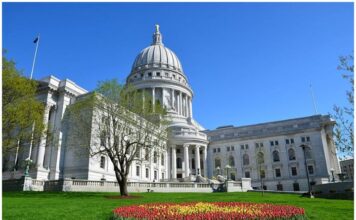(The Center Square) – In April, several education groups, including two national teachers’ unions, urged Congressional leaders to allocate more than $200 billion to education in addition to the CARES Act and federal relief through which Congress had just allocated nearly $31 billion in March.
They requested an additional subsidy of $175 billion for K-12 education at the state level, $13 billion for IDEA and $12 billion for Title I. In March, they had lobbied for $75 billion for additional state aid.
Ultimately, Congress allocated $31 billion funding toward education nationwide. Many higher education institutions were criticized for taking millions of dollars when they were holding hefty endowments, especially after the top 25 universities in the U.S. with $350 billion in total endowments were allocated $800 million in coronavirus aid.
Despite the record level of funding, by June, the U.S. Bureau of Labor Statistics (BLS) reported that 469,000 K-12 personnel, state-run colleges and universities laid off 176,000 professors and other employees. Private schools, including well-known colleges and universities and K-12 private schools, reported 457,000 layoffs.
This is more than the nearly 300,000 education professionals who lost their jobs during the entire period of the 2008 Great Recession, according to an analysis financed by the Russell Sage Foundation.
In total, BLS reported 779,000 layoffs in K-12 public school district personnel nationwide in the months of April and May.
The AFT reported a list of higher education institutions that eliminated full-time faculty positions, imposed hiring restrictions, and furloughed employees.
“While the pandemic has certainly exacerbated the financial issues facing most colleges and universities, the truth is that, for decades, public financial support for higher education has plummeted,” AFT President Randi Weingarten and Rutgers AAUP-AFT President Todd Wolfson wrote in an op-ed. “Dozens of university leaders have announced drastic budget cuts, furloughs, layoffs and even permanent campus closures, instead of dipping into reserves or reducing salaries of highly paid executives and coaches.”
But before the coronavirus ever hit, according to the California School Boards Association, roughly 7 in 10 school districts in California were already facing budget deficits; 40 percent were already considering or issuing employee layoffs to help offset increasing costs.
And after state shutdowns began, an analysis by Brown University found that schools districts and local governments implemented different reopening guidelines and timelines based more on politics or competition with private schools than because of science.
A Reason Foundation analysis of school reopening decisions also found that school districts with stronger teachers’ unions were much less likely to offer full-time, in-person instruction than those with weaker teacher union involvement. Of the 835 public districts that represent roughly 38 percent of all students enrolled in K-12 public schools nationwide, its models also found that school districts in states without right-to-work laws were 14 percent less likely to reopen in person than in states that have such laws in place.
“A 10 percent increase in union power is associated with a 1.3 percentage-point lower probability of reopening in person,” its analysis states. In Florida, 79 percent of 38 school districts in an Education Week dataset were planning to offer full-time in-person instruction to all students. By comparison, all of the 21 school districts included in the dataset for New York, where the teachers unions are stronger, had no plans to offer full-time in-person instruction.
The Reason analysis found that a one percent increase in union membership at the state level was associated with a 1.5 percent point lower probability of reopening in-person instruction. And a 10 percent rise in union workers at the county level was associated with a one percent decline in the probability of reopening in-person.
Meanwhile, the trend of education layoffs reported in April continued through October. According to BLS data, public education employment had fallen to the lowest national total for the time period analyzed compared to the same period in two decades.
According to U.S. Department of Labor estimates, state and local education employment was down 8.8 percent in October from the previous year, “representing the lowest national jobs total at that point in the school year since 2000,” a Pew Charitable Trusts report states. “The cuts were mostly driven by temporary layoffs and positions left unfilled in the new school year.”
“Although teachers account for a portion of the local education cuts, anecdotal evidence suggests that bus drivers, food service personnel, support staff, and other non-instructional positions bore the brunt of the initial reductions as schools shifted to distance learning,” Pew reports.
Corey A. DeAngelis at Reason Foundation notes that teachers “aren’t the only stakeholders in the reopening debate. Keeping schools closed hurts families that need in-person options. Plus, remote learning provided by public districts may turn out to be a disaster for many students already falling behind.”
Instead of funding failing school systems that are increasingly laying off employees, he suggests that federal and state funding be directly allocated to families, “so they can take their education dollars to the schools of their choice.”
“Education funding is supposed to be for educating students, not protecting traditional public schools when other options are available. School districts have the power to choose their own reopening plans,” he adds, arguing that families should have the same options.
By Bethany Blankley | The Center Square
Go to Source
Reposted with permission







![Protecting Portland: No Good Deed Goes Unpunished [REVIEW]](https://www.wisconsinrightnow.com/wp-content/uploads/2025/07/portland-356x220.jpg)























